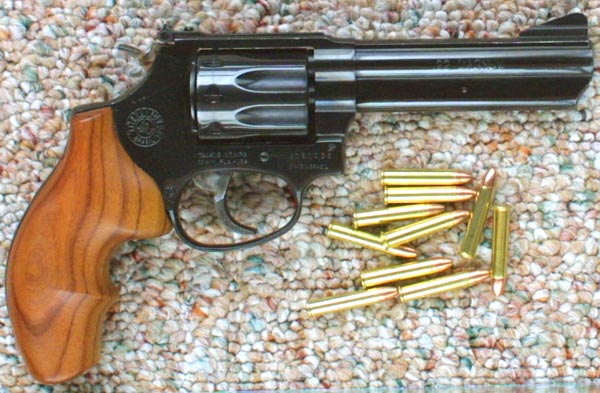 Taurus 941
Taurus 941
| Dimensions | Barrel Length | Weight | Caliber | Action Type | Magazine Capacity |
| 8.75" x 5" |
4" | 25 oz |
22 WMRF |
Revolver |
8 |
I am approaching this subject from a backwards perspective, since I had purchased the newer 17 caliber Taurus first, before purchasing the older model. All of these models are based upon the original Taurus Model 94, in 22 Long Rifle. This original member of the Taurus small frame rimfire family, was such a popular gun, and worked so well, that the company decided to introduce similar models with different chamberings.
The purchase of this gun was the culmination of my long search for an original High Standard Sentinel MKIV revolver, in 22 Magnum. The High Standards were pretty neat little revolvers, unfortunately out of production since the eighties, which formed a whole line of recreational rimfires, camp guns, and kit guns. I did manage to find a High Standard Sentinel MKI, which was the gun of my dreams back in my early teens; but I never did locate a MkIV. One day, I was in the gun shop, and spotted the little Taurus, in 22 Magnum, and decided that this was as good a gun, if not better, than the little High Standard. The price was even right, which never hurts.
This is one of the older Taurus revolvers, being produced before the hammer locking Taurus Safety System. It also has the nicely styled Brazilian wood grips, as
The Model 941 has a smooth, wide trigger, and a rather small spur on the case hardened hammer. It points nicely, the brazilian wood grips feeling good in the hand, and can be considered a good candidate for a kit gun, or for casual recreational shooting, where a little extra power may be desired. Unfortunately, unlike the classic 22 L.R. kit gun, the 941 is not cheap to shoot. Where 22 L.R. ammunition can cost less than 2 cents a round, a box of 22 Magnum sells for about $10. The 22 Magnum, as it turns out, is a rather difficult cartridge to produce, despite it's superficial resemblance to the 22 L.R. If I did not already possess several 22 L.R. firearms, I would probably get a model so chambered, in preference to the magnum, just on the grounds of ammunition cost.
This is an eight shot model. The 22 L.R. version (the model 94) has a nine shot cylinder. Reducing the capacity adds just a bit of metal to the chamber walls. It also permits the slightly larger magnum rounds to be chambered safely. The 22 Magnum was introduced in 1959, as a varmint cartridge. It was initially planned to be a stretched out 22 L.R.; but things got to be a bit complicated, and further modifications needed to be done. The complications were due to the fact that a rimfire cartridge case needs to be made of metal soft enough to have it's rim crushed by the firing pin, so that the primer may be ignited. Attempting to get any kind of pressure generated safely within these cartridge cases is a problem at best. There was also the matter of the case length. Making such a long, narrow cartridge case, particularly using such soft metal, was also an exercise in precision. So though the initial idea was simple enough, because of these problems, the cartridge became something more than just a stretched out 22 L.R. The photo to the left shows a side by side comparison of the standard 22 L.R. along with the newer 22 Magnum, and the newest member of the family, the 17 Magnum. The 17 Magnum is a 22 Magnum, necked down to accept a 17 caliber bullet.
Now for the bad part. This particular Taurus, along with my little Taurus 17C have dismal double action triggers. The trigger action is good enough in single action mode; but reverting to double action makes it feel as if I am firing a cap gun. I noticed this on my Taurus 17C, and had hoped that this was merely a new trigger which needed breaking in; but the trigger is the same on the 941, which was bought used. On the other hand, this gun
Well despite the trigger, I was able to shoot eight shot strings of just under one inch. recoil is negligible, though hearing protectors are absolutely required. The gun is quite a bit louder than you might expect. In contrast to the double action pull, the single action trigger pull is just marvelous, breaking cleanly, and not being too heavy. I can only conclude that this is due to the hammer spring, since the hammer itself is quite stiff to cock. An extra stiff mainspring may have been the Taurus solution to difficulties with positive ignition that these guns reputedly had in the sixties and seventies. Overall, the gun is a pleasure to shoot, is accurate enough, good looking, and a light, handy piece to carry. With the exception of the cost of the ammunition, it is everything that a recreational handgun should be.
The Taurus handgun of today is the product of quite a different company than that produced in decades past. At one time, the quality of these guns was compared favorably with that of S&W itself, though S&W too, has remade itself. Taurus is also able to innovate in ways that S&W has not yet seen fit to do. The Taurus 5 shot 410 revolver comes to mind; but perhaps S&W will catch up. One thing is for certain, The production, and the great improvement of the Taurus product line has been very beneficial to American handgun enthusiasts, both by the availability of it's products, and by the competitive effect it has had on other companies, notably S&W. Taurus is established, and is in for the long haul. I do not see these benefits as coming to an end any time soon.